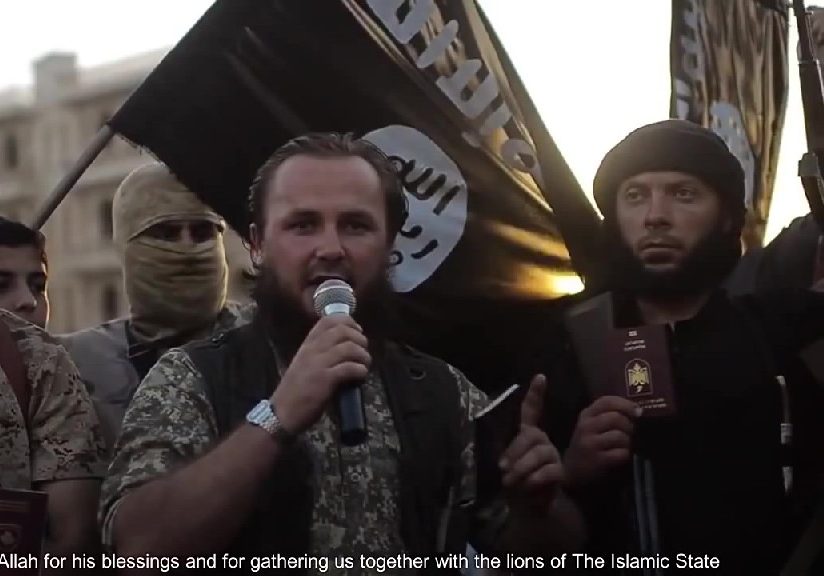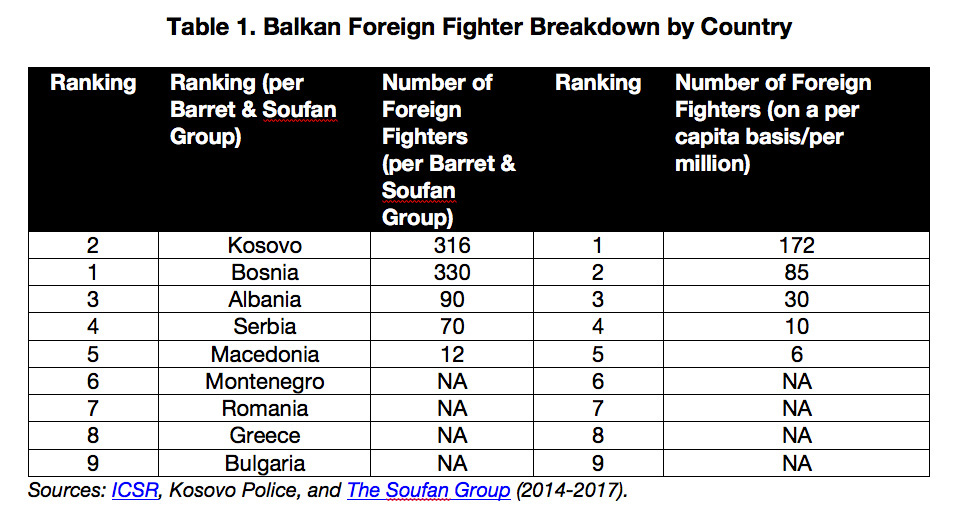This is part one of a two-part series; the second part is HERE.
By Anne Speckhard, Ardian Shajkovci, Lorand Bodo & Haris Fazliu
It is estimated that of the 38,000 foreign fighters who have joined Sunni militant groups, such as ISIS and al-Nusra, in Iraq and Syria, upwards of 875 have originated from the Balkans, with 800 estimated as coming from the western Balkan countries of Kosovo, Albania, Bosnia, and Macedonia. On a per capita basis (per million of its citizens), these four Western Balkan countries have a higher representation of foreign fighters compared to the four Western European countries with the highest per capita foreign fighters of France, Germany, Belgium, and the UK (Speckhard & Shajkovci 2017a).
The ISIS Digital Caliphate and the Need for Counter-Narratives
In the Western Balkans, where unemployment is high and faith in government institutions is low, on-the-ground preachers and ultra-conservative forces, coupled with ISIS’ Internet machinery, spread the vision of alternative Islamic governance, and in the case of ISIS, their Islamic Caliphate, while also exploiting pity for the beleaguered Muslims suffering under Assad’s atrocities to recruit for their cause. Despite being defeated on the battlefields of Iraq and Syria, ISIS continues to successfully disseminate its propaganda globally on the Internet; recruit for, inspire, and even direct terrorist attacks.
In its Breaking the ISIS Brand Counter Narratives Project, International Center for the Study of Violent Extremism (ICSVE) researchers have over the past two years interviewed 71 ISIS defectors, returnees and ISIS cadres prisoners, most captured on video, which are then turned into short counter narrative video clips of insiders denouncing the group and warning others not to join. The video clips have been successfully focus-tested with vulnerable populations and with counter terrorism and Countering Violent Extremism (CVE) experts around the world. They were also used to confront an ISIS emir (Speckhard & Shajkovci 2017b) and to prevent a young teen from travelling to Raqqa.
For this study, we decided to see if we could take these offline results of using the video clips to the digital space to fight with ISIS’ online recruiting. This required finding out if we could identify ISIS endorsers, followers—and even recruiters—on the social media accounts we chose to study—in this case Facebook—and target placement of the videos on their social media accounts. The central guiding questions of our research were as follows: Can we identify ISIS endorsers, followers, and promoters on social media, specifically on Facebook? And if so, how can we infect their accounts with counter-narrative materials, and to what effect?
Indicators Used to Measure Success
To ensure that we reached our intended audience, the authors relied on a stringent research design and expert verification. The following indicators were used to measure the success of our intended objective:
- Identifying accounts that displayed measurable indicators of radicalized behaviors, such as liking, sharing, and distributing ISIS content;
- Engagement of such accounts with our counter-narrative videos;
- The extent to which our counter-narrative video materials were endorsed or shared by our target audience, as measured in terms of “likes,” “clicks,” or views”;
- The extent to which counter-narrative videos led to engagement and discussion on the part of our target audience, showing that the material made them “think again and possibly turn away,” to borrow a tagline from a US State Department’s counter-narrative campaign.
Desired but not verified indicators included:
- The extent to which video materials led to prolonged and sustained attention to the material;
- The extent to which the videos led to a real behavioral change in the online target audience, causing them to turn away from ISIS and its ideology.
Sample Selection
An Albanian-speaking sample consisting of 77 Facebook accounts (15 female and 62 male) representing what we believed to be radicalized individuals was put together in a matter of days. Based on their profile descriptions, their ages ranged from 13 to 51 years old. All of them endorsed or promoted ISIS materials.
Thirty of the 77 accounts were rated as highly radicalized based on their high activity in liking and posting/sharing ISIS material, and two of them claimed to be in Syria fighting for ISIS. One such account was tied to a 13-year old boy who identified himself as an Albanian-speaking boy inside ISIS in Syria. The rest were moderate to low-level followers and endorsers, but by no means ideologues.
During the course of studying these accounts over a two-week period, more than half of our sample disappeared as a result of Facebook’s takedown policy, resulting in a sample of only 31 accounts to which we were able to apply our intervention.
These 31 individuals that remained in the sample were subject to critical analysis. We examined their posts, comments, shares, and likes to identify links to ISIS support. All the participants in this sample had shown support for ISIS in one way or another, such as liking ISIS content, posting ISIS emblems, commenting in support of the organization, posting photos of al-Baghdadi or those of ISIS soldiers, sharing news from ISIS media (Amaq), sharing photos of ethnic Albanians foreign fighters in ISIS, and other ways of endorsing their content.
Twelve of the remaining 31 accounts were rated as highly radicalized, with the rest as moderate to low-levels of radicalization. Some of the profiles tried to disguise their affiliation by not mentioning the word ISIS, caliphate, or khilafah; however, an analysis of their likes and social networks yielded different results. In other words, nearly half of the profiles were considered – with high confidence – as highly radicalized.
Results: Infecting ISIS Online Recruiting Territory
The primary objective of this study was to learn if online counter-narratives could be targeted to Albanian speaking radicalized individuals. Secondly, we attempted to understand if they would have any effect. We learned that we could not only easily discover and communicate with radicalized account holders, but could also, in the very short-term, reach them with our counter-narrative materials.
From the views and share functions of Facebook, we also learned that our videos were clicked on and watched, shared, and even endorsed. It is difficult to estimate the extent to which our video materials caught the full viewing attention of our target audience, however.
The collected statistic on comments/likes and views indicates a trend of increased interest in our videos, though most likely due to a tagline that was added on the second video that likely piqued more interest. The first video received 46 views within 24 hours of posting it, whereas the second received over 270 views in less than 24 hours. Within the 24 hours of posting it, the second video reached 320 views.
Due to the interest in the second video, several account holders started viewing the anonymized account profiles of the researchers and watching the second video, which most likely explains the increase in viewership from 46 to 80. There were more comments added to the video as well. Comparatively speaking, the third video had 140 views only a few hours after it was posted. In total, we know with certainty that all three videos were viewed 540 times (80+320+140); however, we have no evidence to support that all three videos were watched by the sample.
Our counter narrative posts were also purposefully publicly posted to allow more persons other than the tagged account holders to view it. As a result, our posts could reach out (literally) to anyone. In other words, friends of friends can watch the video even if they were not our “friends” or in our sample. We know that some media jihadis also shared the video—probably thinking it was an ISIS video given the thumbnail and video titles that resemble ISIS videos. Thus, they also increased the reach, and most likely other ISIS endorsers watched our video as well.
Conclusion
This study had two goals. Firstly, we wanted to learn if we could reach ISIS supporters, endorsers and distributors on Facebook. Secondly, we wanted to learn if we could meaningfully engage with them, hopefully to diminish their support for groups like ISIS. In this study, we successfully demonstrated that we could reach our target audience.
How well our counter-narratives resonated with our target audience and caused them to be disgusted by ISIS is not easily measured. However, we could observe that they caught the attention of those who received them and led to considerable discussions.
We consider a measure of success if our video materials could even reach to individuals (i.e. awareness metrics) who are already moving dangerously along the radicalization and terrorism trajectory. Any engagement with our video materials on the part of account holders who appear to represent serious ISIS supporters and promoters can be considered a success, given that at that point on the radicalization and terrorist trajectory they will have likely narrowed their focus only to material coming from ISIS. Such individuals will likely only be diverted from the terrorist trajectory by hearing and taking seriously denouncements from those who were inside the group, which is precisely what our counter narratives contain.
As far as meaningfully engaging with them, although disturbing, the comments made by the sample participants demonstrate that they engaged with our materials and thought about them to some extent. This was a short-term study fraught with difficulties in observing effects, so we cannot say that we necessarily dissuaded participants from endorsing or supporting ISIS. However, we do know that we reached them, including their followers, and managed to engage many with our counter narrative materials. Given the alternative of doing nothing and allowing ISIS endorsers and distributors to carry on with no intervention, other than law enforcement, we judge this intervention as a success.
Read the full report here.
Anne Speckhard, Ph.D., is an adjunct associate professor of psychiatry at Georgetown University School of Medicine and Director of the International Center for the Study of Violent Extremism (ICSVE). Follow @AnneSpeckhard on Twitter.
Ardian Shajkovci, Ph.D., is the Director of Research and a Senior Research Fellow at the International Center for the Study of Violent Extremism (ICSVE).
Lorand Bodo, MA, is an analyst at Ridgeway Information. Follow @LorandBodo on Twitter.
Haris Fazliu is a research intern at ICSVE who assisted on field research in the Balkans and carried out the data collection for this study.

